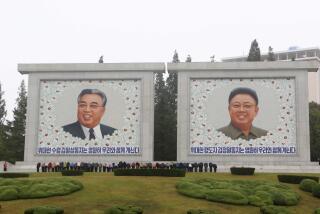U.S.-Backed Units’ Links to Khmer Rouge Reported : Cambodia: Groups may have shared supplies, logistic lines, White House acknowledges. Renewed efforts in Congress to cut off aid are expected.
- Share via
WASHINGTON — The Bush Administration admitted Tuesday that there may have been “tactical military cooperation” in Cambodia between the U.S.-backed non-Communist resistance groups and the murderous Khmer Rouge, which killed more than a million Cambodians in the late 1970s.
In a written submission to Congress, the Administration acknowledged that it has “reports” that some of the military units allied with Prince Norodom Sihanouk have used Khmer Rouge supplies and logistic lines and may even have conducted coordinated attacks along with the Khmer Rouge.
Since 1985, federal law has prohibited the United States from providing any money to Cambodia which has the effect of helping the Khmer Rouge’s fighting capacity, either directly or indirectly.
The new report--which the Administration made public on a day dominated by a flood of Gulf-related war news--could lead to renewed congressional efforts to cut off American aid to non-Communist forces in Cambodia. An effort to cut off covert CIA aid to these groups died in Congress last October.
“At a time when we worry about bringing the international criminal Saddam Hussein to justice for his atrocities, we wink and blink and nod at Pol Pot (the Khmer Rouge leader), who put to death over a million of his countrymen,” said Rep. Chester G. Atkins (D-Mass.).
The language of Tuesday’s study was worded carefully. The Administration did not say definitively that there had been military cooperation between the Khmer Rouge and the non-Communist groups. But it acknowledged that the United States has “reports” of such cooperation, without saying where these reports come from.
Under Pol Pot, the Khmer Rouge ruled Cambodia from 1975 until the beginning of 1979. They were toppled from power when Vietnamese troops invaded the country and installed a new Cambodian government. Although most of the Vietnamese forces departed in 1989, the Vietnam-backed regime, headed by Cambodian Premier Hun Sen, remains in control of Phnom Penh and much of the rest of the country today.
For the past 12 years, the Khmer Rouge, which gets aid and military supplies from China, has been operating from base camps along the Thai-Cambodian border and inside Cambodia to try to overthrow the Phnom Penh government.
At the same time, two non-Communist groups also have been challenging Hun Sen’s regime with the support of the United States. One of these groups is headed by Sihanouk, the former Cambodian monarch, and the other is headed by former Cambodian Prime Minister Son Sann.
Throughout most of the 1980s, all three resistance groups, including the Khmer Rouge, were joined together in a political coalition, headed by Sihanouk, which represented Cambodia at the United Nations. However, U.S. officials have repeatedly said that the non-Communist groups operated independently and that the United States strongly opposes any return to power by the Khmer Rouge.
More to Read
Sign up for Essential California
The most important California stories and recommendations in your inbox every morning.
You may occasionally receive promotional content from the Los Angeles Times.












